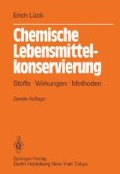Zusammenfassung
Die antimikrobielle Wirkung von Pyrokohlensäureestern wurde zuerst von H. Bernhard, W. Thoma und H. Genth beschrieben [1]. Pyrokohlensäurediethylester war Mitte der 60er Jahre in einigen Ländern für die Konservierung von Wein und alkoholfreien Erfrischungsgetränken bedeutsam geworden. Seit etwa 1973 ist das Produkt weltweit als Behandlungsmittel für Wein wieder verboten worden, nachdem toxikologisch relevante Nebenreaktionen beim Zerfall des Produktes bekannt geworden sind. Deshalb ist inzwischen für alkoholfreie Erfrischunggsgetränke stattdessen in der Bundesrepublik Deutschland Pyrokohlensäuredimethylester eingeführt worden [2].
Access this chapter
Tax calculation will be finalised at checkout
Purchases are for personal use only
Preview
Unable to display preview. Download preview PDF.
Spezielle Literatur
Bernhard, H., Thoma, W. und Genth, H. (Farbenfabriken Bayer, Leverkusen): Konserviemngsmittel. Deutsches Patent 1011709 and US-Patent 2 910400
Genth, H.: Dimethyldicarbonat — ein neuer Verschwindestoff für alkoholfreie, fmchtsafthaltige Erfrischungsgetränke. Erfrischungsgetränk 13, 262–269 (1979)
Pauli, O. und Genth, H.: Zur Kenntnis des Pyrokohlensäurediäthylesters. I.Mitteilung. Eigenschaften, Wirkungsweise und Analytik. Z. Lebensm. Unters. Forsch. 132, 216–227 (1966)
Ough, C.S. und Langbehn, L.: Measurement of methylcarbamate formed by the addition of dimethyl dicarbonate to model solutions and to wines. J. Agric. Food Chem. 24, 428–430 (1976)
Stafford, P.A. und Ough, C.S.: Formation of methanol and ethyl methyl carbonate by dimethyl dicarbonate in wine and model solutions. Am. J. Enol. Vitic. 27, 7–11 (1976)
Löfroth, G. und Gejvall, T.: Diethyl Pyrocarbonate: Formation of urethane in treated beverages. Science 174, 1248–1250 (1971)
Ough, C.S.: Ethylcarbamate in fermented beverages and foods. II. Possible formation of ethylcarbamate from diethyl dicarbonate addition to wine. J. Agric. Food Chem. 24, 328–331 (1976)
Solymosy, F., Antoni, F. und Fedorcsäk, I.: On the amounts of urethane formed in diethyl pyrocarbonate treated beverages. J. Agric. Food Chem. 26, 500–503 (1978)
Kielhöfer, E. und Würdig, G.: Nachweis und Bestimmung von Diäthylcarbonat und Pyrokoh- lensäurediäthylester im Wein und Schaumwein. Dtsch. Lebensm. Rundsch. 59, 197–200 (1963)
Hecht, G.: Zur Toxikologie des Pyrokohlensäurediäthylesters. Z. Lebensm. Unters. Forsch. 114, 292–297 (1961)
Pound, A.W.: The initiation of skin tumours in mice by homologues and N-substituted derivatives of ethyl carbamate. Austr. J. Exp. Med. Sci. 45, 507–516 (1967)
Schmähl, D., Port, R. und Warendorf, J.: A dose-response study on urethane carcinogenesis in rats and mice. Int. J. Cancer 19, 77–80 (1977)
Genth, H.: On the action of diethylpyrocarbonate on microorganisms. Proc. 4th Int. Symp. on Food Microbiol. Ans Göteborg 1964, S. 77–85
Peterson, T.W. und Ough, C.S.: Dimethyldicarbonate reaction with higher alcohols. Am. J. Enol. Viticult. 30, 119–123 (1979)
Daudt, C.E. und Ough, C.S.: Action of dimethyldicarbonate on various yeasts. Am. J. Enol. Viticult. 31, 21–23 (1980)
Author information
Authors and Affiliations
Rights and permissions
Copyright information
© 1986 Springer-Verlag Berlin Heidelberg
About this chapter
Cite this chapter
Lück, E. (1986). Pyrokohlensäureester. In: Chemische Lebensmittelkonservierung. Springer, Berlin, Heidelberg. https://doi.org/10.1007/978-3-642-96924-9_26
Download citation
DOI: https://doi.org/10.1007/978-3-642-96924-9_26
Publisher Name: Springer, Berlin, Heidelberg
Print ISBN: 978-3-642-96925-6
Online ISBN: 978-3-642-96924-9
eBook Packages: Springer Book Archive

